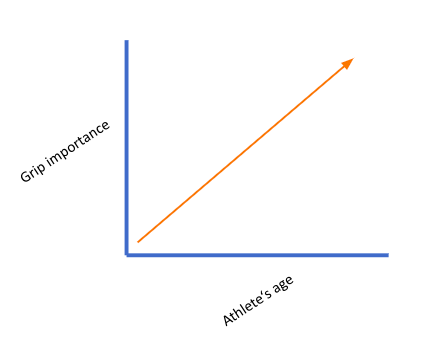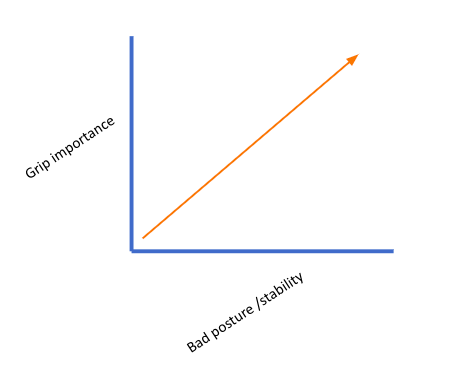Grip importance - our theory!

Grip importance - Our theory
Written by: Simon Sparber - Angles90 Founder & CEO
How important is a good grip? You probably won't like the answer: It depends!
In the following graphs I will try to explain how seven different factors can have an impact on grip importance.
You might be asking yourself now what a „good grip“ actually means: In a nutshell, it means having the right wrist position. According to several studies and the world‘s best personal trainers the neutral grip (palms faced to each other), in the best case one that can be freely moved, is our most natural and thus healthiest wrist / grip position. The comfort of the grip or handle itself is not taken into account in this article.
Grip importance increases with exercise weight
Example:
Completely supinated biceps curls may harm your tendons and joints less than a fully supinated pull-up since there is less weight involved in the former.
Pull-ups, lat pull-downs, rows and deadlifts all count to the most complex upper body exercises where athletes use the most weight. So especially take care of which grip position you are using while doing these exercises.
Grip importance increases with volume
Example:
How volume plays a role in a single training session: Doing two sets of fully supinated pull-ups followed by another two sets of neutral grip pull-ups may be fine. Doing six sets in a fully pronated or supinated grip may be not. Choosing a mix of all grip positions while still keeping your focus on the neutral grip might be key.
How volume is important over longer periods of training: As a beginner, your joints probably may not hurt for months, no matter how wrong you are lifting weights! Don’t get biased or overconfident about how your body feels in the short-term. Some things only show in the long-term.
Grip importance depends on your arm-shoulder flexibility
Example:
The more flexible you are, the more freedom of motion your joints and tendons will have – even in rather unnatural grip/exercise positions like lat pulldowns, behind the neck pulldowns or pronated deadlifts. This does not mean that an athlete with a high arm-shoulder flexibility should perform exercises in an unnatural way just because he can. But this does also not mean that the usage of freely movable grips is an excuse to neglect your flexibility and to invest time in improving it!
More control of your grip let’s you target your muscles better
Example:
The more control you have over your grip position, the better you will be able to target exactly those muscle groups you aim for. For example, while a parallel arm position (neutral grip) at pull-ups may be the best for joint health, having your arms positioned somewhere in the middle between a neutral and pronated grip will engage your anterior shoulder in the best way. Also, here is where grip width comes into play: Very narrow or wide grips enable you to hit different muscle fibres, but the more you distance yourself from the classic shoulder-wide grip (be it narrow OR wide), the more vulnerable your joints may get. This is why it especially makes sense to opt for freely movable handles when going very narrow or very wide.
Grip importance increases with your age
Example:
Pretty self-explanatory, but here a little anatomical explanation: The older you get, the more work, pressure and tension your joints were absorbing during your lifetime. Therefore, chances are higher they may now suffer from micro-damages and/or inherit less fluids. At the same time, a healthy grip may be able to increase solid muscle mass around sensitive joints in a way they will become less vulnerable in the future. The more muscles you have, the more they will absorb pressure that your joints would otherwise have to deal with.
Grip importance increases the more arm- or shoulder injuries you had
Example:
This one should be self-explanatory too!
The more injuries you had, the more likely it is that your joints are injury-prone in general. The more severe these injuries were, the more careful you have to be while working out and thus also while choosing your grip position. If you are injured at the moment, chances are you can only use a few, certain grip angles in order to workout pain-free. In this case, it can be advisable to continue working out in these few angles to maintain your muscle mass. At the same time, though, you should obviously tackle the main problem together with a physiotherapist or similar.
Grip importance increases when your posture is bad
Example:
Sounds abstract? It is not! The typical leaned-forward shoulders we all know from people who sit too much for too long, make you push and pull weights out of a more injury-prone position. The more grip freedom you have while working out, the more you can outbalance this issue.This does obviously not mean that you should not work on improving your posture anymore!.
By the way, the mentioned posture issue might also prevent you from hitting your desired target muscle. For example, a leaned-forward posture will tend to engage your shoulders too much while bench pressing and your lats too little while doing pull-ups.
About The Author
Apart from being founder and CEO of Angles90, Simon (28) is a lifelong health and fitness enthusiast with a master’s degree in business. Originally hailing from a small town in the Italian Alps, he spent over 15 years as a gymnast and won numerous local titles. An accident in the mountains, however, forced him to give up his passion and gravitate to traditional gym-based strength training. During this change, Simon experienced weight training-related shoulder problems. But the agility, flexibility and natural movement of gymnastics meant he was always pushing back against stereotypical, old school gym advice. An intensive engagement in functional training principles, as well as a tight network of physiotherapists and personal trainers, eventually contributed not only to his shoulder’s healing, but also to the success of Angles90 today.











